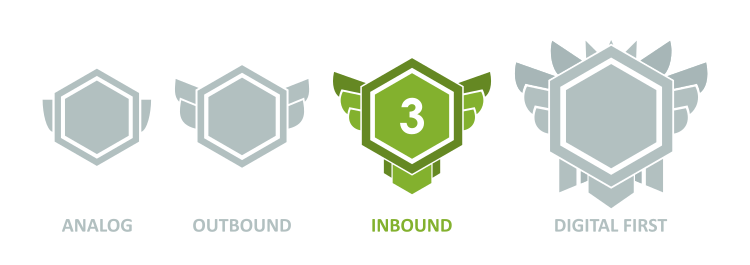Well, congrats! Your company's digital maturity is high.

What does a typical inbound marketing company look like?
Inbound marketing companies have understood the need to engage buyers online with a multi-channel approach.
These companies typically master outbound marketing techniques.
They have a clear commitment to be multi- or omni-channel, they know the best channels to use, and how to use them.
Inbound marketing is a top priority, with a strong focus and significant investments in content creation.
Their website is designed to generate leads, and they extensively use SEO and SEA to drive more traffic.
They have implemented marketing automation to nurture their leads with message personalization, and automatically score their leads to detect the most interesting ones.
They screen all their leads and have dedicated resources to qualify their MQLs and dispatch viable opportunities to their sales team.
However, lead management is often the main bottleneck of the inbound marketing companies. They have low conversion rates, and some of their sales reps are not fully onboard with these processes or priorities.
These companies have difficulties tracking KPIs and seeing the results of their inbound actions.
Despite the investment, content creation often lacks the resources to be fully effective.
Please note that this description is a composite of typical inbound-marketing companies based on SpecialChem experience. You may fully or partially recognize your company from this list.
How can you upgrade to the next level?
We recommend the following next steps:
- Scale-up your content creation capacity. To fully benefit from inbound strategies, you need a real content farm with an ideal target of one content per day. You are able to address all the stages of your buyer's journey with relevant and valuable content for your top-priority buyer personas in your segments.
- Be omnichannel and exploit multi-channel retargeting. You need to have a clear understanding of the best channels used by your prospective customers in every market. Learn how to retarget them on these channels to maximize your chances of being considered at every stage of your buyer's journey.
- Master SEO and SEA to be an organic leader in your segment. Hire resources or outsource your SEM (Search Engine Marketing) management to optimize your ad budget, keep up with the latest search engine updates, and constantly implement the latest best practices.
- Optimize your lead conversion process. Build a lead qualification process within your organization. Screen all your leads and score them to easily detect the MQLs (Marketing Qualified Leads) among them. Appoint dedicated inside salespeople to qualify all your MQLs. Track your conversion rate to identify bottlenecks.
- Prioritize excellence in your KPI tracking. Make sure to track all your revenues to their sales and marketing origin. Track the influence of all your sales and marketing actions to see which ones have the greatest impact on your conversion.
- Break the sales and marketing silos. Your sales reps are a great source to feed your content plan with tons of valuable topics. Your sales and marketing teams must work hand in hand to ease and optimize your buyers' journey.
- Upgrade your website with great UX, personalization, chat, and multi-event tracking.